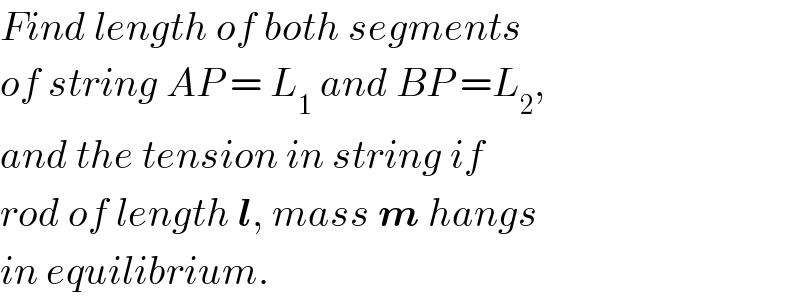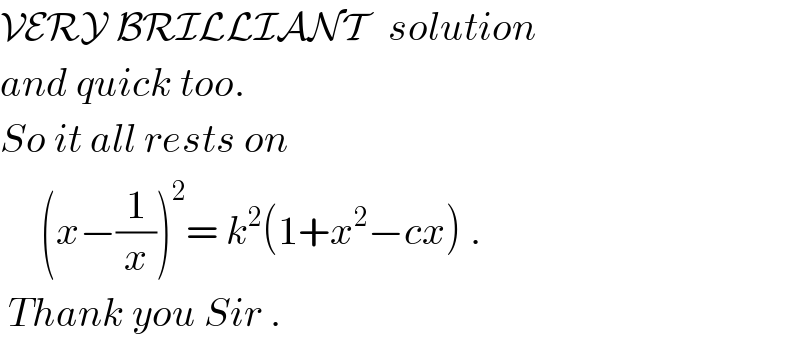
Question and Answers Forum
Question Number 48268 by ajfour last updated on 21/Nov/18

Commented by ajfour last updated on 21/Nov/18

Commented by mr W last updated on 21/Nov/18

Commented by ajfour last updated on 21/Nov/18

Commented by mr W last updated on 21/Nov/18

Answered by mr W last updated on 21/Nov/18

Commented by mr W last updated on 27/Nov/18
![OP′=l sin θ=l_1 ∠AOP′=α (a/(sin ϕ))=(l_1 /(sin (α+ϕ))) ...(i) (b/(sin ϕ))=(l_1 /(sin ((π/2)−α+ϕ)))=(l_1 /(cos (α−ϕ))) ...(ii) ⇒b cos (α−ϕ)=a sin (α+ϕ) ⇒b(cos α cos ϕ+sin α sin ϕ)=a(sin α cos ϕ+cos α sin ϕ) ⇒b(1+tan α tan ϕ)=a(tan α+ tan ϕ) ⇒(b tan ϕ−a)tan α=a tan ϕ−b ⇒tan α=((b−a tan ϕ)/(a−b tan ϕ)) ...(iii) sin α=((b−a tan ϕ)/(√((a^2 +b^2 )(1+tan^2 ϕ)−4ab tan ϕ))) cos α=((a−b tan ϕ)/(√((a^2 +b^2 )(1+tan^2 ϕ)−4ab tan ϕ))) from (i): ((sin α)/(tan ϕ))+cos α=(l_1 /a)=((l sin θ)/a) (1/(√((a^2 +b^2 )(1+tan^2 ϕ)−4ab tan ϕ)))[((b−a tan ϕ)/(tan ϕ))+a−b tan ϕ]=((l sin θ)/a) ⇒((ab)/(l(√((a^2 +b^2 )(1+tan^2 ϕ)−4ab tan ϕ))))((1/(tan ϕ))−tan ϕ)=sin θ we get ϕ from this eqn. then we get α from (iii). AP′=((a sin α)/(sin ϕ)) ⇒L_1 =(√((l cos θ)^2 +(((a sin α)/(sin ϕ)))^2 )) BP′=((b cos α)/(sin ϕ)) ⇒L_2 =(√((l cos θ)^2 +(((b cos α)/(sin ϕ)))^2 )) ⇒T=((mg)/(2[(1/(√(1+(((a sin α)/(l cos θ sin ϕ)))^2 )))+(1/(√(1+(((b cos α)/(l cos θ sin ϕ)))^2 )))])) ================= (b tan α−a) tan ϕ=a tan α−b ⇒tan ϕ=((a tan α−b)/(b tan α−a)) ⇒sin α (((b/a) tan α−1)/(tan α−(b/a)))+cos α=((l sin θ)/a)](Q48280.png)
Commented by ajfour last updated on 21/Nov/18

Commented by ajfour last updated on 21/Nov/18

Commented by mr W last updated on 21/Nov/18

Commented by mr W last updated on 22/Nov/18

